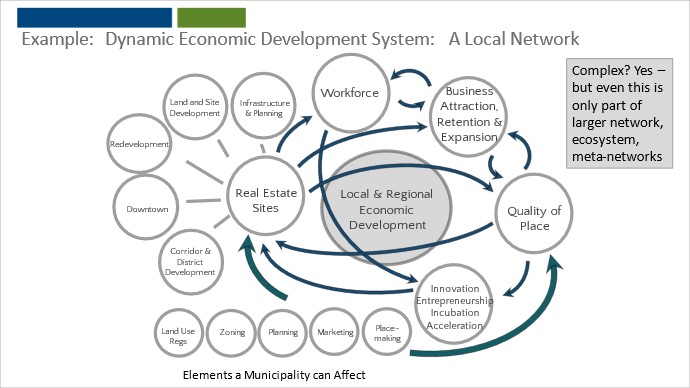 The practice of economic development serves many types of organizations and functions. This includes public entities at the municipal, county, state, and federal levels as well as private companies and not-for-profit entities such as chambers of commerce, industry associations, and regional organizations.
The practice of economic development serves many types of organizations and functions. This includes public entities at the municipal, county, state, and federal levels as well as private companies and not-for-profit entities such as chambers of commerce, industry associations, and regional organizations.
The functions and focus of these organizations may be different based on varying definitions of “economic development” and the different needs of the geographic areas represented. Most involve some form of planning, organizing, and acting to support the economy with some common end goals being:
- Job stability and creation
- Tax base stability and growth
- Diversification of economy and tax base
- Wealth creation and diversification
Economic development, however, is more than just goals and tools. It is a process performed and influenced by human behavior. Economic development operates within a dynamic system of people, networks, and organizations. Within this dynamic and human system, key functions include interactions, relationships, communications, and collaboration. In such a system, no one entity can effectively serve the functions and meet desired outcomes in isolation.
Therefore, it is important in strategic planning for economic developers to understand these systems and build capacities for systems thinking. Doing so will provide a clearer understanding of the surrounding environment regarding economic behavior and the multiple factors and agents (people, organizations, networks) influencing economic activity and outcomes. It will also help individuals and their organizations define their roles and relationships to others within the system. In turn, systems thinking and acting will enable stronger connections among diverse agents and opportunities for collaboration, which makes the economic development system more adaptable and resilient.
To help us better understand systems thinking, the graphic below portrays the “parts of the elephant vs. whole elephant” metaphor. Individuals observing and acting alone have a narrow focus and might describe the elephant by one of its parts failing to see how all the parts combine to form an elephant.
 Source: “An Introduction to Systems Thinking for Tackling Wicked Problems,” Gerald Midgley, Centre for Systems Studies, https://lnu.se/en/meet-linnaeus-university/current/events/2021/seminar-midgley-210304/
Source: “An Introduction to Systems Thinking for Tackling Wicked Problems,” Gerald Midgley, Centre for Systems Studies, https://lnu.se/en/meet-linnaeus-university/current/events/2021/seminar-midgley-210304/
In applying systems thinking to economic development, consider the following chart depicting a hypothetical example of an economic development system.

Source: Camoin Associates
This system is complex and within it exists multiple “agents” (people, organizations, and networks). These agents can be formal or informal in terms of how authority is derived. They can be structured or open in terms of allowing access and participation. There can be both strong and weak relationships among participants in terms of frequency and intensity of communication, coordination, and collaboration. And they each can and often do have visions and missions that may or may not overlap, which is very important to understand in strategic planning.
So, given this complex and dynamic system of economic development, how can planning, strategizing, and acting take place to achieve goals and outcomes?
First, start with the premise that the strength and resilience of an economy depends on how diverse people and their related entities communicate, connect, and interact internally and externally.
Then, take the time to dialogue with participants and understand their diverse missions, roles, perspectives, visions, and goals. This will build trust among individuals and organizations, and trust is the “currency” of networks. It enables the emergence of transactions that, in turn, can lead to long-term collaboration.
In the case of an economic development strategic planning process, it is important to take the next step and work with your partners and stakeholders to specify, describe, understand, and agree to roles and responsibilities within the planning process and economic system both now and going forward. This includes specific strengths and responsibilities among the roles of:
- Planning
- Organizing
- Funding
- Technical expertise
- Communications
- Public relations
- Facilitation
- Evaluating
In sum, systems thinking and acting are important for building a strategic planning process that will result in long-term adaptability and resiliency. It also can easily be integrated into the core process components of preparing, organizing, and engaging:
- Prepare: Plan the process. Are we ready and who is “we”? Do we have the resources and capacity for the process?
- Organize: Who is this plan for? Individuals? Organizations? Networks? Systems? All of the above? Who benefits? Who is impacted, or impacts/connects with others
- Engage: How do we communicate internally and externally about the strategic planning purpose and process? How do we engage for “commit-in” vs. “buy-in”? Are we prepared and organized for and welcoming diverse inclusion? Multiple and creative methods are welcome!
More Resources
For more information and examples on this topic, I have prepared slide decks along with some other helpful strategic planning-related resources for your use. Check out my Economic Development Strategic Planning Resources web page.





